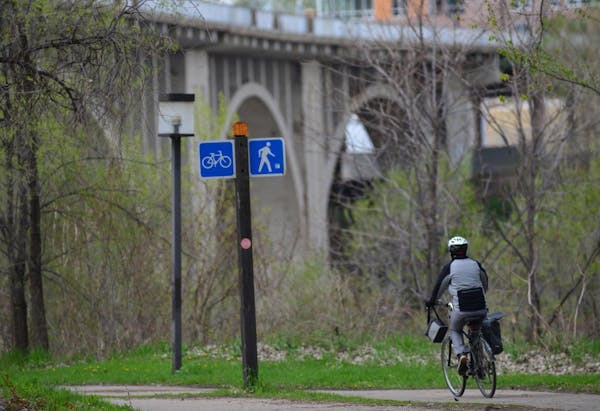Minneapolis park officials Wednesday night rejected a proposal to remove 10 mile-per-hour speed limits on park bike paths after the plan ignited an online debate among drivers, bicyclists and pedestrians.
Park board opponents said they found the proposed new rule requiring bikers to use "reasonable and prudent" speed too vague. Some bristled at the idea of bike paths as speedways.
"It really is a recreational bike path system and not a commuter system, and I want people to know that," Board Member Jon Olson said.
Debate over the proposal caught fire online and on bike paths around the city among residents and trail users furious about collisions and near-misses, even with the existing limits.
Lake Calhoun biker Fred Davis, of Minneapolis, said that only three days ago he was passed by a bicyclist he estimated was tripling the current numerical limit. "If I had been making a left turn, he'd have taken my arm off," said Davis, 69.
Some faster cyclists already use the parkways instead of the bike paths, in part because state law sanctions that and in part due to the path speed limit. Yet a majority of a dozen or so exercisers interviewed Wednesday said they didn't even know there was a limit of 10 mph. That's despite the limit being painted periodically on paths used by bikers, skateboarders and in-line skaters.
Repealing the limit of 10 mph would be fine with cyclist Mike Anderson, of Brooklyn Center, who said slowing for congestion and speeding up where there's no competition for path space is something he practices already. "How am I supposed to know if I'm going 10 or not?" asked Anderson, whose bike lacks a computer. He guessed he averages 12 mph.
Law enforcement officials say they have no real ability to police limits; they can't remember the last time someone was ticketed for speeding on the pathways.
On Wednesday, Park Police Chief Jason Ohotto took handheld laser measurements of riders on W. River Parkway.
Bicyclists he recorded averaged speeds of 14 mph during 15 minutes of speed checks.
Ohotto said that against a priority of keeping inner-city parks safe from gangs and violence for kids, tagging speeding bikers isn't high on the list.
Only one of 13 bikers he tracked was under 10 mph, going 8 mph. The fastest whizzed by at 20 mph. But even that biker wouldn't necessarily have run afoul of the 1981 ordinance requiring "reasonable and prudent" speeds, given conditions. That's because traffic of one bike per minute is hardly congested.
Bikers not being aware of their speed is one factor Ohotto cited for why repealing a fixed numerical limit makes sense. He used as an example one cyclist who stopped to ask him about his speed measurements Wednesday. He asked her to guess her speed. She guessed 5 mph to 8 mph. She was going 14 mph.
"The crux of the problem is that bicycles, especially recreational cyclists, don't have any idea how fast they're going," Ohotto said.
Board Member Annie Young said that bike speed enforcement "is a waste of police officers' time." But her point of view didn't prevail at the board meeting.
Park Superintendent Jayne Miller, who proposed dropping the 10 mph limit, was absent, away attending a parks conference.
Davis, from Lake Calhoun, pedals a heavy recumbent bike at a speed that he said makes 10 mph an aspiration. Sometimes he's passed by fast runners.
He said a limit of 10 mph sounds "a little slow," but 15 mph or 20 mph seems more reasonable — with enforcement. "The city should hire a bicycle cop to ride around, and these guys going two or three times the speed limit should get a ticket, or at least a warning," he said. Board Member Anita Tabb called speeds on Cedar Lake's bike path "just scary."
Hopkins resident David Camacho, a walker new to the lakes' paths, said separation of bike and walking paths is what's important. That's something the Park Board began in the 1970s after a biker fatally struck a pedestrian on a combined path at Lake Harriet in 1972.
Typically, the Park Board combines pedestrians and bikers only during snowplowing months, when bike speeds are somewhat reduced.
Cyclist Grace Dymond, of Minneapolis, said she typically rides at a moderate pace. "I don't feel unsafe on the paths and concerned about how fast people go," she said. "Going a reasonable speed is working. I never hear about accidents."
But her companions, hauling a bike trailer with a cranky baby, were headed home. "We're going to bike as fast as we can," one said as they rode off.
Steve Brandt • 612-673-4438
Twitter: @brandtstrib
One day in the frantic life of a Children's Minnesota emergency room nurse
State Sen. Nicole Mitchell off committee assignments while case under review

GOP endorses Tad Jude for congressional seat Dean Phillips is leaving

